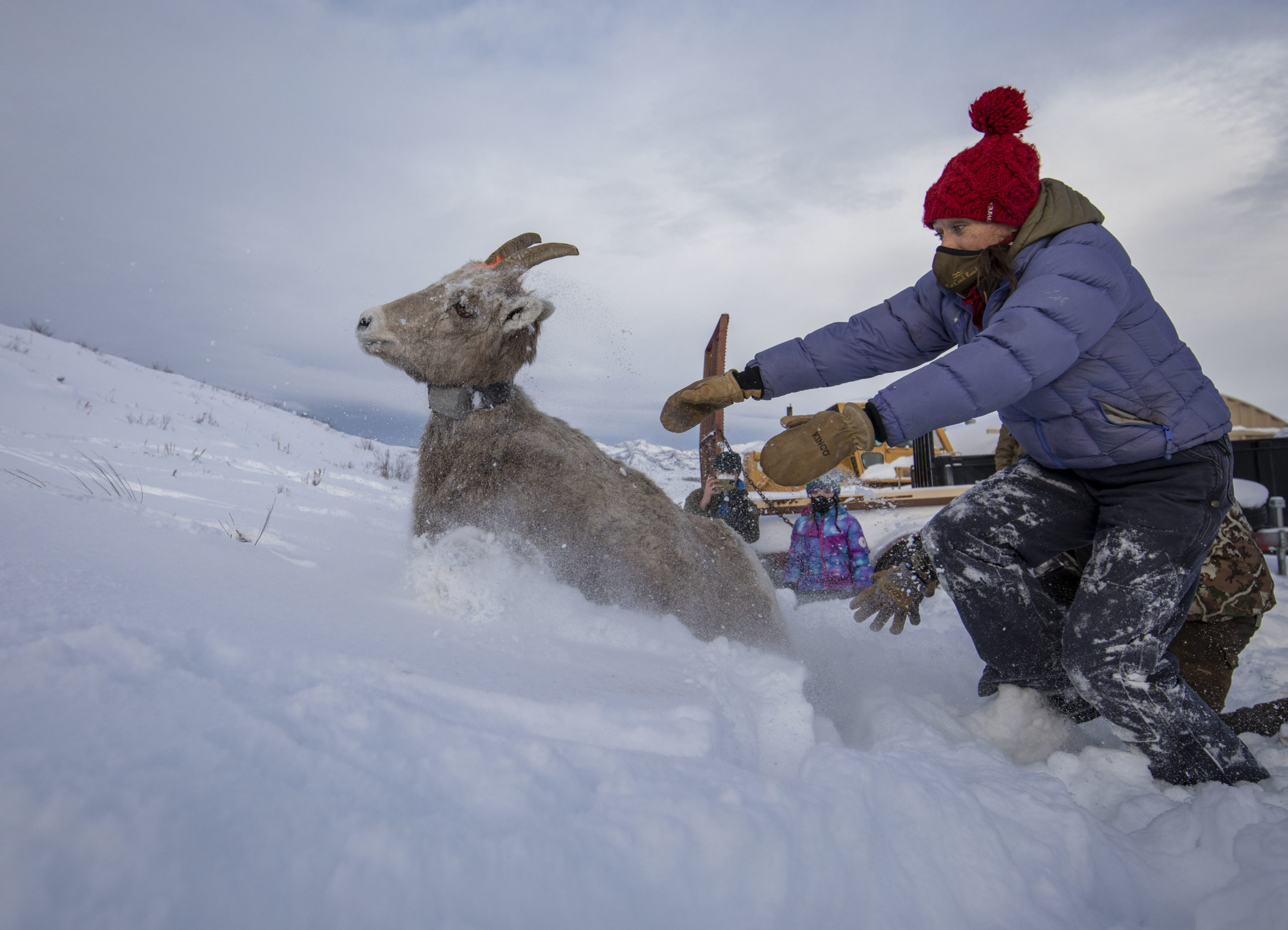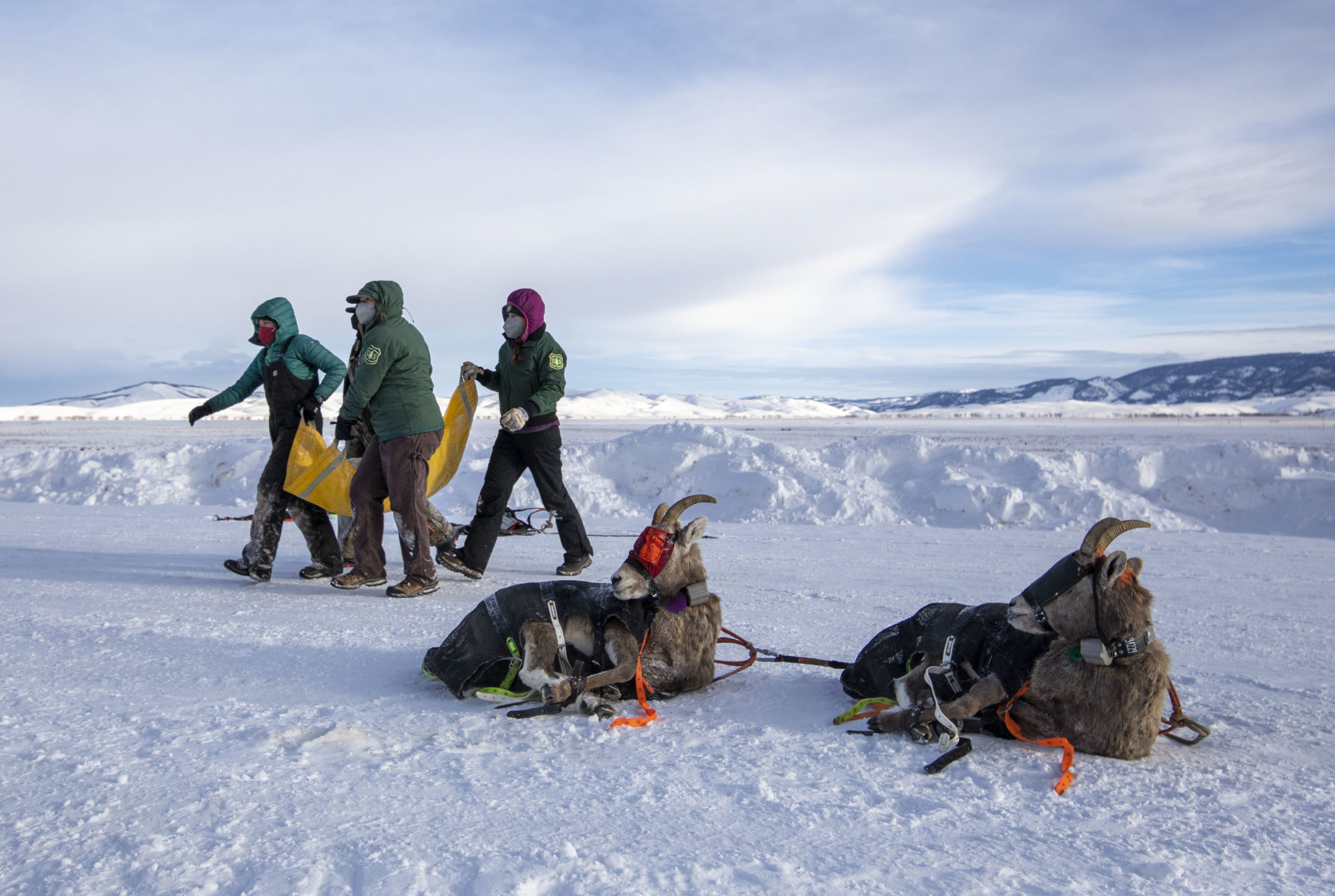Biologists worry about die-off after ewe hunt failed to substantially cull pneumonia-prone bighorn herd

By Billy Arnold
Jackson Hole News&Guide
Via- Wyoming News Exchange
JACKSON — For the past few years the Gros Ventre range has been crowded — at least by bighorn sheep standards.
Biologists counted 505 wild sheep in the hills in February 2022. The year before they tallied 491.
The last time they found as many was in 2001. The trouble is, when biologists count roughly 500 animals in the Jackson Herd, which lives in the mountains east of Jackson Hole, pneumonia tends to claim spectacular proportions of the herd. In the early 2000s pneumonia killed as many as 70% of the sheep that dwell in the Gros Ventre in the span of a few years.
In recent summers bighorn lambs collared for an ongoing nutritional study have died. Pneumonia was the culprit.
That’s new, at least in the last 10 years, as bighorn populations have rebounded from the last die-off.
“The fact that a couple of the collared lambs have died this summer from pneumonia is a little bit of a red flag,” said Aly Courtemanch, a Wyoming Game and Fish Department wildlife biologist who studies the bighorns that dwell in the greater Teton area.
“Is something potentially brewing?”
Courtemanch and other researchers say it’s too early to know. But the lambs that died have them on alert, and Courtemanch is asking members of the public to report signs of sickness when they’re out watching wildlife. The Jackson area wildlife biologist can be reached at 733-2321.
Courtemanch is particularly interested in hearing from people ogling sheep wintering in the Gros Ventre or on the National Elk Refuge, where they scamper up and down Miller Butte, delighting passers-by and wildlife photographers. Those sheep are part of the Jackson Herd. In recent weeks Game and Fish spokesman Mark Gocke took a picture of a sheep with a runny nose. Cute, yes. But also a sign of disease.
“Every winter we get a few sheep that are coughing and snotty,” Courtemanch said.
The sniffling sheep doesn’t mean that there’s a large-scale die-off in the works, she said. But if wildlife managers do start hearing more about sheep displaying symptoms, they’ll be concerned. Then biologists could start going out and doing targeted surveys of the bighorn population.
Some surveys have already been completed for the early winter. On a cold Saturday in December on the refuge, Courtemanch and other biologists flitted around preparing for a helicopter to drop off a batch of collared bighorn sheep. The helicopter flew out over Miller Butte and the Gros Ventre, looking for the 25 or so animals that have been collared for an ongoing study of sheep fat, disease and reproduction.
The helicopter netted the sheep and then dropped off “muggers” to blindfold and hobble the animals to safely ferry them to the researchers. State, federal and university scientists then poked and prodded the sheep, taking ultrasounds to see how fat — and, consequently, healthy — the sheep are while swabbing their throats for signs of pneumonia.

The study is largely directed by the Monteith Shop, the University of Wyoming’s ungulate research lab headed by Kevin Monteith. The researchers are looking at how chunky the sheep are, how much disease they’re carrying, how many babies they’re having, and how many of those babies are growing up to be fat, happy sheep — or not. They also want to know how each of those factors influences the others: whether fatter sheep are less likely to catch disease, for example. The goal is to figure out why the Jackson Herd rebounds after pneumonia die-offs while other herds, like some around Dubois, do not.
The study also complements a new management strategy Courtemanch and other Wyoming Game and Fish officials are trying: killing a few ewes to save the rest of the herd.
The hypothesis is that as more sheep dwell in the Gros Ventre they compete with their woolly brethren for food, decreasing fat stores and their overall nutritional health. When those fat stores drop, researchers think the sheep may be more susceptible to pneumonia. So they authorized 16 tags for hunters to take ewes this past fall in the Gros Ventre. Once the population is reduced below 500 animals, wildlife managers hope to see fat stores improve — and the Jackson Herd avert a die-off.
Hunters, however, were only able to take seven sheep this year, fewer than Courtemanch had hoped.
“Seven ewes is making a small dent,” she said. “But not a big enough dent for what we’re hoping to achieve.”
Game and Fish may propose increasing the number of tags issued next season.
In the meantime, it’s unclear whether the hunt will have the desired effect. Monteith, the University of Wyoming researcher, said preliminary results from the study, which began in 2015, suggest good fat stores might not drastically help bighorns keep bugs that cause pneumonia at bay.
Monteith did, however, say that data shows sick sheep are often less fat than healthy herd mates. Catching one of the pathogens that causes pneumonia can consume as much fat off a sheep’s body as rearing a lamb. Nutrition is the foundation of everything animals do, Monteith said, so having less fat stored on their bodies is likely to make sheep less resilient to harsh conditions.
“It’s legit,” Monteith said. “It’s going to mean that they’re going to be less capable, less robust to contending with change. From bad winters to droughts, to whatever it may be.”
Monteith and Courtemanch said it’s too early to say whether the lambs that died with pneumonia over the summer are harbingers of a larger die-off. Some sheep looked healthy in December. But an analysis of the nutritional data collected last month wasn’t available at press time.
Courtemanch is waiting to see how many sheep are counted this February before proposing any specific changes to Wyoming’s ewe hunts in the Gros Ventre.
“We don’t want to bring the population down super fast,” Courtemanch said.
The goal, instead, is to bring the population “down slowly over the next few years.” Initially, that will mean cutting the population below 500 animals. Eventually, wildlife managers may try to bring the population down even further toward the objective of roughly 400 sheep in the Gros Ventre.
In the meantime, Courtemanch encourages wildlife watchers to call in if they see any signs of sick sheep.





